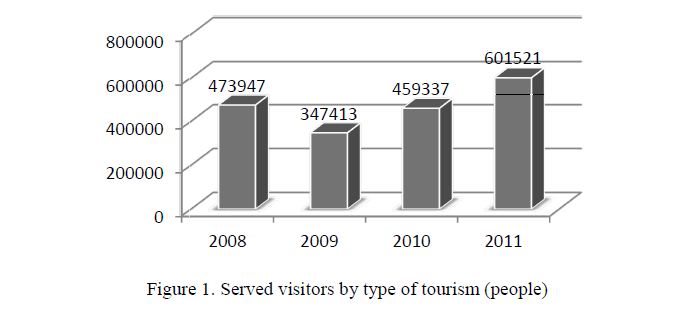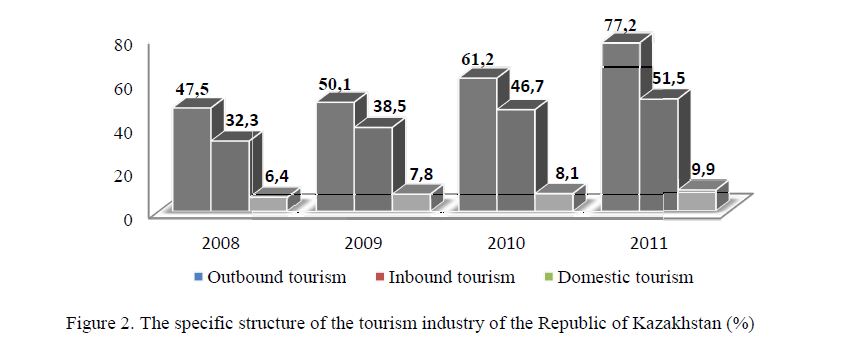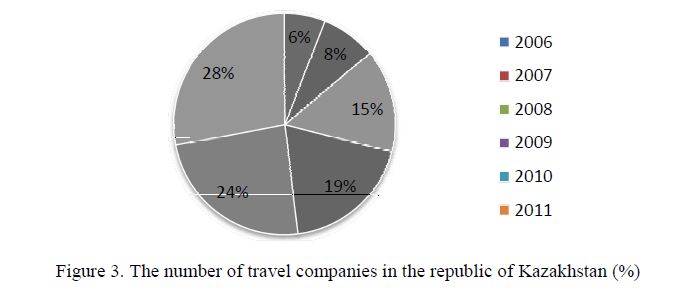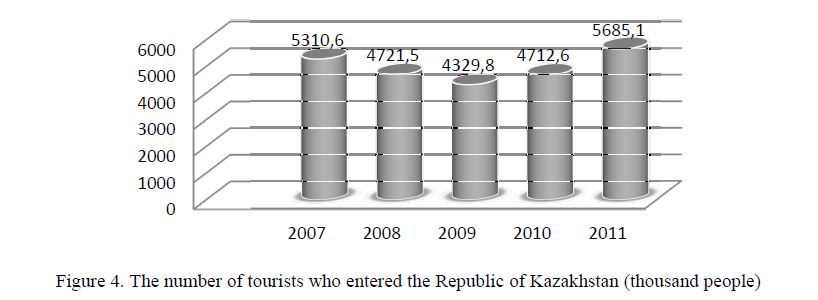This article describes the research of current state and analysis of prospects for the tourism development in the Republic of Kazakhstan, including the following objectives solved: the basic theoretical aspects of tourism are studied; the value of tourist activity in the economy of the Republic of Kazakhstan is revealed; the structure of the tourism industry is studied and the potential of the tourism resources of the country is analyzed; the analysis of the factors influencing on the development of tourism in the country is carried out, the main directions and prospects of tourism development in the Republic of Kazakhstan are revealed. The study was performed on the basis of data from the Agency of Statistics of the Republic of Kazakhstan.
The majority of experts believe that Kazakhstan is not fully using its capabilities to develop tourism, and yet an extensive international experience shows that the tourism industry is one of the most promising sectors of the economy. Tourism growth has to occur mainly due to the appearance of new visited areas, as traditional areas of the world tourism market have already reached the limits of recreational capacity. In this regard, Kazakhstan has a unique opportunity to occupy its niche in the global tourism market.
Kazakhstan, having a rich tourist and recreational potential, is characterized by insufficient level of tourism development. Its share in the gross domestic product is around 0.3 %. The data in table 1 shows that in 2011 volume of incomes from tourism activities made up 145.3 billion tenge, which is 2 times higher than in 2008 (77.6 billion). Paid taxes to the budget of the republic made up $20,6 billion. The number of people employed in the industry was 158 700 [1].
Analysis of the tourism industry development for the period of 2008–2011
T a b l e 1

Investments in the fixed assets in tourism totaled 143.7 billion tenge in 2010, 178.9 billion tenge in 2011. It should be noted that the investment in fixed assets in the sectors producing goods and providing services, tends to rise. The quantitative measures of tourism industry growth show progressive and sustainable industry trends (table 2).
The dynamics of the tourism industry for the period 2009–2011
T a b l e 2

According to the data shown in table 2, at the end of 2011 the republic had 1,567 tourism organizations and 601,521 people have been served by travel agencies, that is more than in the previous year for 23.6 % (459 337 people in 2010). Total volume of services rendered in 2011 increased in comparison with 2009 by % and amounted to 78 483.5 thousand tenge [1].
By analyzing the variation of the main economic indicators of tourism development, it can be concluded that the potential of Kazakhstan's tourism is not fully realized as the development of the tourism industry depends on the creation of a modern competitive tourist complex, including the infrastructure of transport and logistics system, also taking into account the reconstruction of the crossing points through the state border of the Republic of Kazakhstan (road, air, rail), providing ample opportunities to meet the needs of local and foreign citizens in tourism services. Creating a tourist complex will also make a significant contribution to the economy through tax revenues, foreign exchange inflows, increasing the number of jobs, as well as providing control over the conservation and management of cultural and natural heritage.
Recently there has been a significant increase in the interest of foreign tourists in the tourist attractions of the Republic of Kazakhstan. This phenomenon, first of all, is caused by the geographical location of the republic, a great potential in the field of attractive tourist routes, etc. Tourist attraction of Kazakhstan is due to the presence of unique natural areas and nature reserves, historic and cultural attractions on world level. Proper use of these resources contributes to the development of almost all types of tourism in the country.
The graph shown in figure 1 shows that the average annual increase in tourism activity range 2 % per year. So, for the period from 2008 to 2011, the number of tourists served increased from 473,900 people nearly 1.3 times and amounted to 601,500 people.

Figure 1. Served visitors by type of tourism (people)
In the structure of tourist activity, domestic tourism made up 32.2 %, inbound tourism — 5.7 %, outbound tourism — 62.1 %. If compare these figures with the data in 2010, then an increase in outbound tourism from 56.4 % to 62.1 %, a reduction in domestic 35.4 % to 32.2 % in the overall structure of tourist services (fig. 2) is observed [1]. Analysis of inbound tourism flows in Kazakhstan shows that the country is not sufficiently attractive for foreign tourists, and therefore the number of tourists arriving in the country, far behind the pre-crisis levels.

Figure 2. The specific structure of the tourism industry of the Republic of Kazakhstan (%)
Currently, the share of outbound tourism is much higher than the proportion of inbound and outbound tourism. And they have been known to bring the main income from this sector of the economy to domestic GDP. Today, about 750 travel companies that cooperate with the 80 countries of the world operate in the country. And only about 20 % of them provide services on attracting tourists to the country and on domestic tourism (fig. 3) [1].

Figure 3. The number of travel companies in the republic of Kazakhstan (%)
The next type, indicating the level of tourism industry development of the country is inbound tourism. The total number of foreign residents who entered Kazakhstan in 2011 amounted to 5,685,132, which is more for 20.6 % than in 2010 (fig. 4) [1]. Most foreign residents come from three neighboring countries: the Republic of Uzbekistan (34.0 %), the Kyrgyz Republic (27.1 %) and the Russian Federation (23.7 %). The main reasons for their visit were private (76.9 %) and transit trips (17.0 %), while business travel and tourism for the purpose of leisure and recreation made up 6.1 %. Many foreign visitors entering the republic stay with their families or friends, they travel by transit or day-trippers. Most visitors from the Republic of Uzbekistan and the Kyrgyz Republic are migrant workers.

Figure 4. The number of tourists who entered the Republic of Kazakhstan (thousand people)
The number of visitors for outbound tourism was 8,020,400 in 2011, which is more for 8.2 % than in 2010. Such volumes of outbound tourism contribute to the formation of negative tourism balance (more than 422 million U.S. dollars) in the balance of payments of the country. Kazakhstan remains «a tourist donor» for countries such as the republic of Turkey, China, the United Arab Emirates, the Kingdom of Thailand, where the tourism industry is developing rapidly creating new jobs and improving the structure of the balance of payments and increasing the well-being of the population (table 3).
The number of tourists entering and leaving Kazakhstan
T a b l e 3

The share of domestic tourism. According to the Agency on Statistics of the Republic of Kazakhstan, the share of domestic tourism has increased in 2007, while travel companies served 89.3 million tourists, this figure increased to 150 thousand people in 2009. Among all types of tourism share of domestic one reached up to 24 %.
Today’s situation of the domestic tourism in the market is characterized by the following factors: the demand for tourist services in Kazakhstan is limited by material possibilities of citizens, few camping sites that provide a sufficient level of comfort. Inconsistency of interests in the relationships of the internal market tour operators and spa complex enterprises in the country leads to dissatisfaction with the needs of Kazakhstani citizens. Each year, the amount of buying the vouchers increases by an average of 5 %, and in 2009 reached a size of 376 million tenge. Income of the Republic of Kazakhstan from travel agencies’ activities on internal tourism is increasing every year by an average of 2.3 % and in 2011 made up 1,035 million tenge.
Thus, a sustained and sustainable development of Kazakhstan's tourism is confirmed by the pace of inbound and outbound tourism growth. The greatest development of domestic tourism is observed in Astana, Almaty, and East Kazakhstan, Karaganda, Almaty and Akmola oblasts. The outbound tourism is the most developed one in Almaty, Karaganda, North Kazakhstan and West Kazakhstan oblasts.
In Kazakhstan, the main directions of development of the tourist industry as a form of tourism clusters to improve the competitiveness in the tourism market at the expense of synergetic effect are decided. Five tourism clusters: Astana, Almaty, East Kazakhstan, South Kazakhstan and West Kazakhstan can be created in the country.
Every tourism cluster should organize the development of several tourist products, it is necessary to develop six major tourism products in the Republic of Kazakhstan: «MICE-tourism», «Cultural tourism and tour», «Active and adventure holidays», «Holidays in the mountains and on the lakes», «Beach tourism» and «Short stay» [2].
The development of tourism products above mentioned implies the need for development of various tourism projects, so such major projects of national importance like health-resort zone Burabay in the cluster Astana, ski resort South Kaskelen and Kok Zhaylau in the cluster Almaty, Buhtarma — Katon-Karagay in the cluster East Kazakhstan and Kenderli in the cluster West Kazakhstan are initiated by the Government of the Republic of Kazakhstan.
It is encouraging to note the fact that putting in a claim for hosting EXPO-2017, Kazakhstan has fully used its considerable experience in the implementation of important international initiatives. For instance, the chairmanship of the OSCE in 2010, in the OIC in 2011–12., the convocation of the Congress of World and Traditional Religions (2003, 2006, 2009, 2012), the organization of Winter Asian Games in 2011 and the annual Astana Economic Forum. Kazakhstan's multiple view foreign policy is successful in the form of good relations with major world powers such as the U.S.A, China, Russia, the EU, but also with the countries of Asia and the Asia Pacific region [3].
Selection of Astana as the host of EXPO 2017 will bring new opportunities for the revitalization and development of European and Asian countries. Well-chosen theme of the exhibition allows to introduce the latest technology in the field of clean energy and to consider the possibilities of its use in a country rich in oil, gas and uranium. The geopolitical location of Kazakhstan and its foreign policy, of course, will continue to strengthen cooperation with the states, both east and west of the Great Steppe.
Thus, foregoing data demonstrate the increasing role of international tourism in the economy of Kazakhstan at the moment, and the prospects for the development of tourism in the near future.
The following proposals for the use of the results of this work, as well as suggestions on further implementation of the work in this direction are put forward:
- creation of prerequisites for the opening of small travel companies that have the human and material resources that promotes investments in the tourism sector;
- development of transport infrastructure. Increasing the number of both scheduled and charter The development of tourism is limited by high transport costs; therefore it is necessary to create conditions for the opening of specialized transport companies for tourist activities. Moreover, it is necessary to establish a system of electronic booking and travel planning;
- statistical record keeping in accordance with international standards and complex impartial record of the economic effects from tourism activities;
- training the qualified personnel for the tourism industry appropriate to the international standards of modern education;
- raising the level of funding the tourism development in the
In conclusion, it should be noted that in order to for tourism industry to become highly profitable, as world experience in tourism development shows, it is necessary to consolidate the efforts of all participants in the tourist market, the public and private sectors. And here the role of the Government of the Republic is to coordinate policy development and planning in the tourism industry at the international, national and private levels.
With comprehensive solution of all problems outlined above, no doubt, the creation of a competitive tourism industry capable of business cooperation within the framework of international trade in services in the field of tourism and recreation will be provided in the coming years.
References
- Tourism of Kazakhstan. Statistical collection of the Agency of Statistics of the Republic of Kazakhstan, 2007–2011, Astana, 2012.
- Concept of tourism development in the Republic of Kazakhstan to Provision of Government of the Republic of Kazakhstan from February, 28, 2013, № 192.
- nomadic.kz